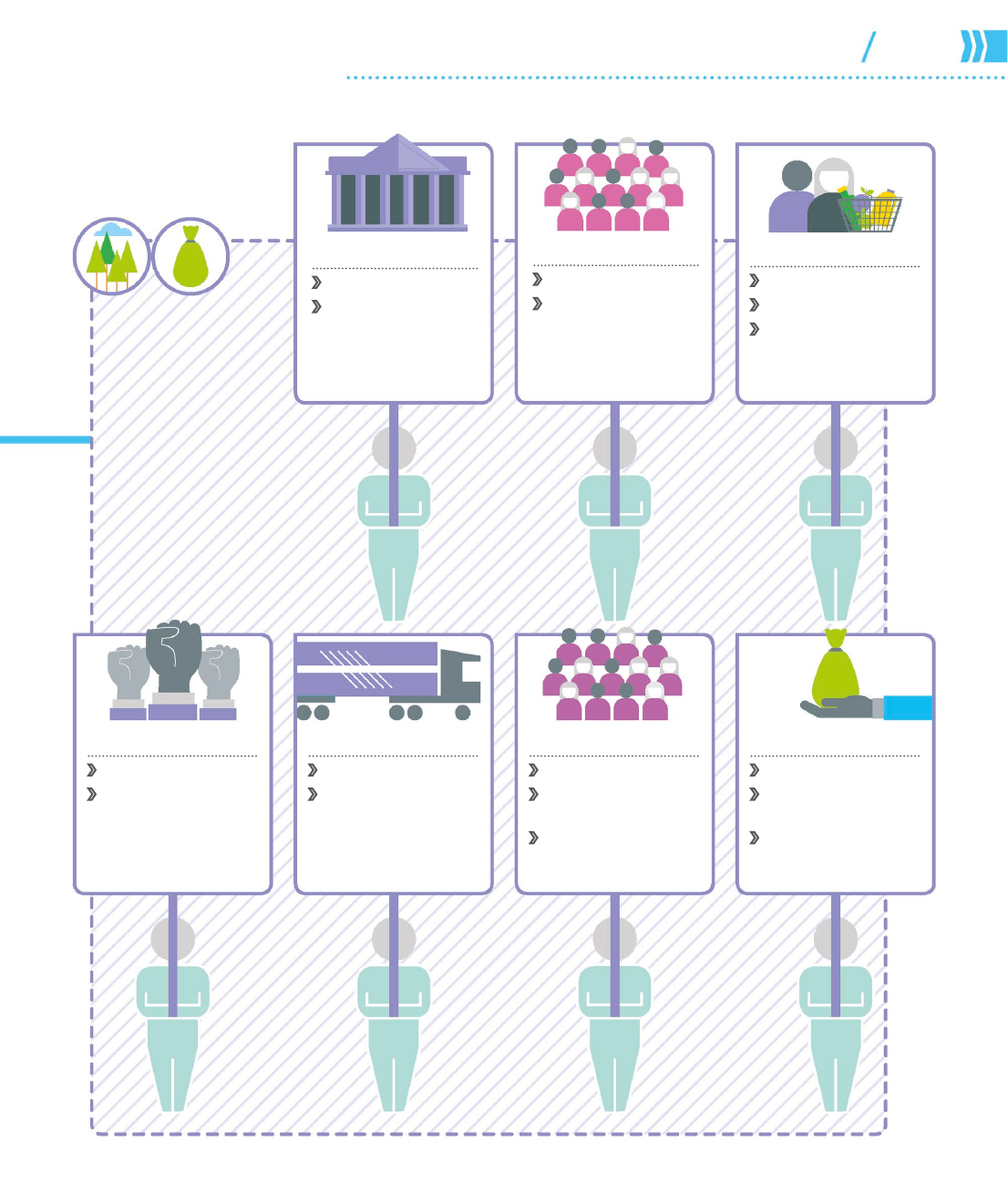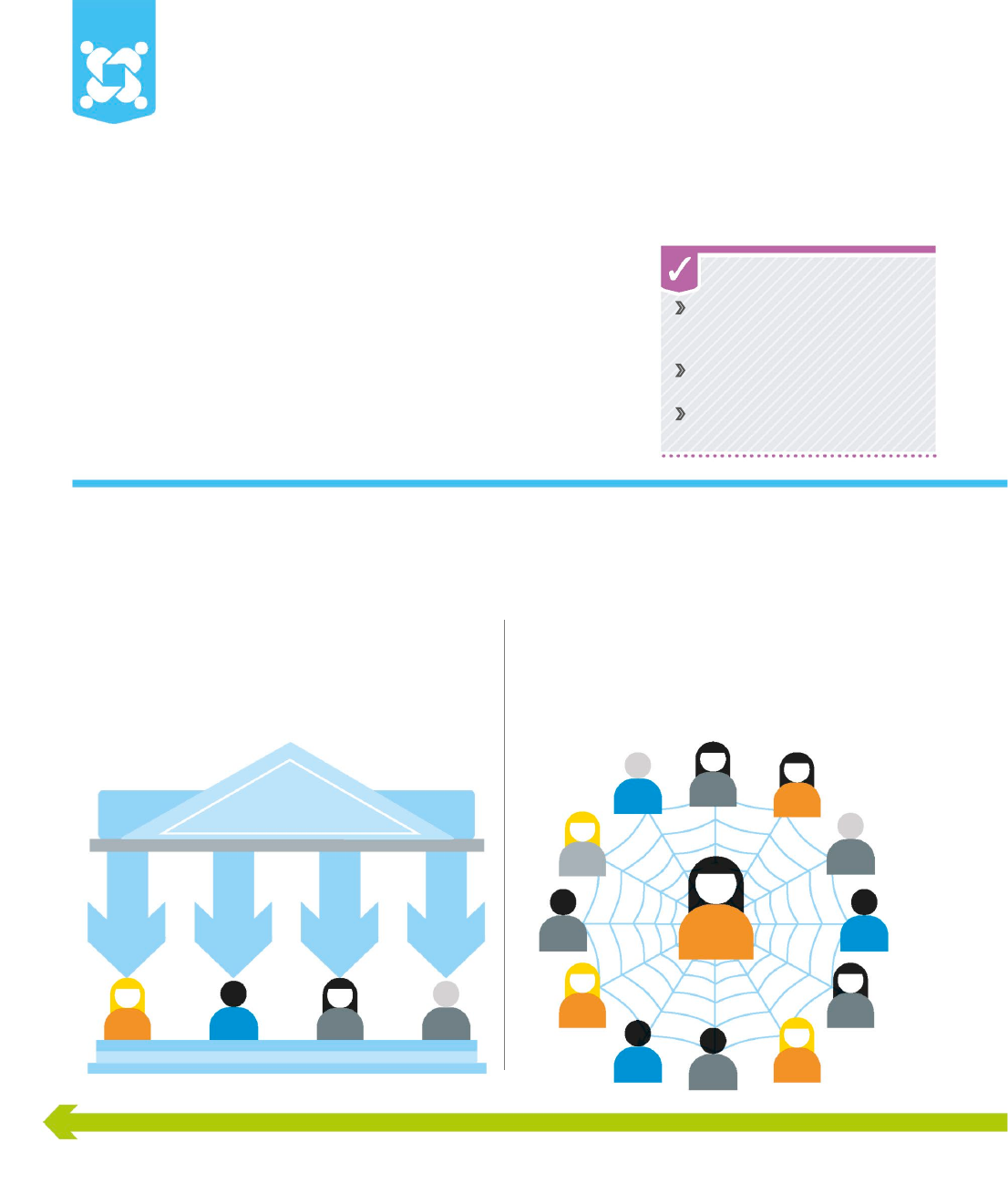
How it works
Because shareholders part-own the company, they
have the right to vote on how it is managed and
to receive a share of its profits. All shareholders are
stakeholders, since the performance of the company
has a direct impact on the value of the shares they
own: when the company does well, the share value
rises, and when it performs badly, the share value falls.
However, stakeholders can also be non-shareholders—
individuals or groups who have an interest in what the
company does or whose financial situation depends on
the company. Some stakeholder groups are interested
in a company mainly for its ethical treatment of workers,
sustainable approach to the environment, and attitude
to society. These are known as environmental, social,
and governance (ESG) criteria.
Stakeholders’ areas of interest
A few stakeholder groups are concerned only with environmental, social, and governance
(ESG) factors, while others, such as shareholders and suppliers, may be more interested in
the company’s financial performance. Most stakeholder groups have at least some interest
in both areas, especially since negative publicity for a company can cause share prices to fall.
Stakeholders
A stakeholder is anyone who is affected by the performance of the
company, while shareholders own one or more shares in a company,
which makes each of them a part-owner of the company.
Nongovernmental
organizations
Contribution to
enviromental and
social causes
Legal compliance
Community
Impact on local
inhabitants
Concern for broader
social welfare
Stakeholders with ESG concerns
Stakeholders have no direct involvement, but
believe that companies have a responsibility to
the communities they operate in, to respect the
environment, human rights, and animal welfare.
$892
mil lion
the average drop in market
value triggered by negative
news about a company’s
human rights record
US_060-061_Shareholders_vs_Stakeholders_1_Steve.indd 60 21/11/2014 16:21
60 61
Suppliers
Ability to pay debt
Enough liquidity
Employees
Pay and benefits
Longevity of the
company
Employment prospects
Shareholders
Ability to pay dividend
Increase in share value
Lenders
Ability to repay loans
Integrity of
management
Financial strengths
of the company
Customers
Quality product
Good value
Customer service
Trade unions
Treatment of workers
Fair pay, benefits, and
working conditions
Government
Tax payments
Legal compliance
$
$
$
$
how companies work
Who’s who
Stakeholders
with economic
and ESG concerns
Stakeholders use ESG—a
recognized part of policy
and reporting for most
companies—to evaluate
corporate behavior
and to determine future
financial performance.
Concerns range from
profits to ethics.
$
US_060-061_Shareholders_vs_Stakeholders_1_Steve.indd 61 21/11/2014 16:21

60 61
Suppliers
Ability to pay debt
Enough liquidity
Employees
Pay and benefits
Longevity of the
company
Employment prospects
Shareholders
Ability to pay dividend
Increase in share value
Lenders
Ability to repay loans
Integrity of
management
Financial strengths
of the company
Customers
Quality product
Good value
Customer service
Trade unions
Treatment of workers
Fair pay, benefits, and
working conditions
Government
Tax payments
Legal compliance
$
$
$
$
how companies work
Who’s who
Stakeholders
with economic
and ESG concerns
Stakeholders use ESG—a
recognized part of policy
and reporting for most
companies—to evaluate
corporate behavior
and to determine future
financial performance.
Concerns range from
profits to ethics.
$
US_060-061_Shareholders_vs_Stakeholders_1_Steve.indd 61 21/11/2014 16:21

STAKEHOLDERS
How stakeholders affect share value
In April 2010, an offshore oil rig owned by British Petroleum (BP) exploded
in the Gulf of Mexico. BP attempted to alleviate stakeholder concerns, but
stakeholders responded negatively, starting their own social media campaigns
to shame the company. Sixty-six days after the oil spill, BP’s share value on the
New York Stock Exchange had dropped by 52 percent.
Stakeholders in action
Compared with other stakeholders,
shareholders have the most interest
in the financial performance of a
company. They are also forced to
take an interest in how seriously
the company takes its corporate
social responsibility (CSR),
whether or not they are socially
and environmentally conscious
themselves. Several high-profile
cases have shown how stakeholder
reaction has caused a significant
decline in share prices. By using
social media, stakeholders
can generate a storm of public
disapproval, leading to angry
consumers and nervous investors.
Stakeholder social media
campaign intensifies.
News breaks that spill is
worse than BP claims.
US government criticizes
BP and sends company a
$69billion bill for cleanup.
Obama administration
advises it could take legal
action to stop BP paying from
dividends to shareholders.
Share price drops 7 percent
in London trading.
News media report on the
stakeholder backlash.
$60
$0
$30
BP shares trading at
$60.57
on April 20, 2010
$60
$0
$30
$69
BILLION
Bill
US_062-063_Shareholders_vs_Stakeholders_2.indd 62 21/11/2014 16:21
62 63
How companies work
Who’s who
the increase in the number of publicly
traded companies* reporting on ESG
* in the Bloomberg database for the period 2008–2011
75%
News media report on
the event.
Stakeholders use social
media to voice anger and
concern over perceived
lack of responsibility by BP.
Conservationists warn
of wildlife devastation.
Celebrities offer to help in
the cleanup. Stakeholders
call for more disclosure
from BP.
Oil rig explodes, killing
11 employees and spewing
millions of gallons of oil into
the Gulf of Mexico.
Five of BP’s top 10
shareholders sell off stock.
By June 25, BP’s share price
has dropped by more than
half; over 34 billion shares
have been bought and sold.
BP starts social media
campaign on Twitter—
initially to minimize the
impact of the spill.
BP shares trading at
$23.91
on June 25, 2010
Inhabitants along the
affected coastline
Local fishermen
Oil spill cleanup
workers
Environmental
activists
BP employees
BP shareholders
Gasoline buyers
Tourists and tourist
businesses
Media
Government
General public
BANG!
BANG!
$60
$0
$30
Stakeholders of the BP oil spill
@
#
$
$
!
US_062-063_Shareholders_vs_Stakeholders_2.indd 63 21/11/2014 16:21

62 63
How companies work
Who’s who
the increase in the number of publicly
traded companies* reporting on ESG
* in the Bloomberg database for the period 2008–2011
75%
News media report on
the event.
Stakeholders use social
media to voice anger and
concern over perceived
lack of responsibility by BP.
Conservationists warn
of wildlife devastation.
Celebrities offer to help in
the cleanup. Stakeholders
call for more disclosure
from BP.
Oil rig explodes, killing
11 employees and spewing
millions of gallons of oil into
the Gulf of Mexico.
Five of BP’s top 10
shareholders sell off stock.
By June 25, BP’s share price
has dropped by more than
half; over 34 billion shares
have been bought and sold.
BP starts social media
campaign on Twitter—
initially to minimize the
impact of the spill.
BP shares trading at
$23.91
on June 25, 2010
Inhabitants along the
affected coastline
Local fishermen
Oil spill cleanup
workers
Environmental
activists
BP employees
BP shareholders
Gasoline buyers
Tourists and tourist
businesses
Media
Government
General public
BANG!
BANG!
$60
$0
$30
Stakeholders of the BP oil spill
@
#
$
$
!
US_062-063_Shareholders_vs_Stakeholders_2.indd 63 21/11/2014 16:21

How it works
The organizational culture of every
business is different, reflecting
the ethos of the company, its
workplace habits, and the image
the company projects. It is also tied
to the type of work that has to be
done. In a high-stakes financial
trading company, the pace and
pressure of the work makes the
atmosphere of the corporate
environment crackle, whereas
in a company relying on creativity
for its products, the mood is likely
to be more relaxed. The type of
incentives offered to management
and employees may also affect the
workplace, resulting in either a
competitive or a collaborative
culture, or a mix of both.
Types of corporate cultures
Management experts have tried to explain how organizational cultures work.
Charles Handy, a former professor at the London Business School, describes
them in terms of four major types: power, task, role, and person.
Control systems Used by
managers to set standards and
measure performance
Leverage Power to influence a
person or situation
Paradigm Value system of
goals, mission, and beliefs
Business cultures
Every organization has a particular workplace environment,
consciously or unconsciously shaped by the personalities, values,
and behavior of the people leading it and working in it.
NEED TO KNOW
Power culture
Driven by a powerful individual at the center of the
organization, who is relied on for decision-making and
the company’s successes. Those closest to the center
have most influence. Typical of a family-owned business.
Role culture
Where a company is based on the structural support of
specialized roles. Each role is crucial and will persist even
if the person occupying it leaves. Procedures and systems
are strictly followed, as in a government department.
bureaucratic / controlling
POWER
JOB
DESCRIPTIONS
PROCEDURES
RULES
SYSTEMS
DECISIONS MADE
US_064-065_Business_Culture.indd 64 15/12/2014 12:55
64 65
HOW COMPANIES WORK
Who’s who
Many factors reinforce a culture. To bring about change, the workforce needs
to be inspired by different motivations, values, and types of role models.
WHAT SHAPES CORPORATE CULTURE?
Task culture
Project-oriented work where a project’s completion is
the motivating force. Relies on teamwork and individuals’
expertise, but results are more important than personal
objectives. Found in technology companies, for example.
Person culture
Company power and influence is shared among individuals
who work semi-autonomously. Individuals count for more
than the company, which is made up of people with similar
specialist training, such as in an architects’ practice.
entrepreneurial / flexible
86%
of senior
managers
in global
organizations
agree that
organizational
culture is critical
to success
Organization size
Big business, or
small company
Company structure
Strict hierarchy,
or power shared
among many people
Founding values
Includes origination
myths and stories
Symbols
Titles, dress codes,
interior aesthetic
Control systems
Rewards, incentives,
performance
assessment
Leaders
Their personality
and behavior
P
A
R
T
N
E
R
S
H
I
P
TASK
TASK
TASK
US_064-065_Business_Culture.indd 65 21/11/2014 16:21
..................Content has been hidden....................
You can't read the all page of ebook, please click here login for view all page.
